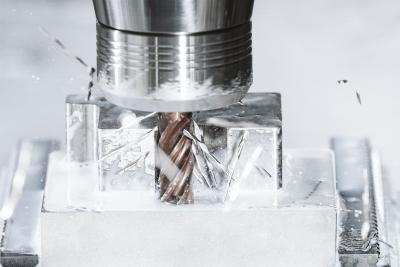
Ceratizit USA Inc. says it redesigned its MonsterMill – ISO-S line of milling cutters to provide manufacturers efficient cutting, long tool life, and excellent surface finishes when milling nickel- and titanium-based alloys. In addition to its 4- and 5-flute cutters, the MonsterMill – ISO-S line now includes a 6-flute cutter for superior surface finishes that reduce secondary operations.
Machining Inconel, Hastelloy, Waspaloy and other nickel-based alloys demands more from tools than conventional metals. The high tensile strength and extreme hardness of superalloys rapidly accelerates tool wear and drives up machining costs. The MonsterMill – ISO-S series, however, excels in machining those difficult-to-machine materials with a perfectly balanced combination of solid carbide, advanced geometries and tough coatings that deliver consistent and reliable smooth cutting action.
“Machining nickel-based alloys comes with its own set of challenges,” said Eric Gerringer, Technical Director, Ceratizit USA. “One of the challenges is the materials’ low thermal conductivity that keeps heat concentrated in the tool instead of dispersing it into the chips. We modified the geometry to keep the heat generated by the machining process as low as possible. Polished chip flutes and an optimized coating also minimize machining friction and ensure efficient chip flow.”
Ceratizit designed its DPX22S Dragonskin coating on these cutters specifically for machining nickel-based alloys. The coating is applied in 4-6 mm layers to provide high thermal stability and outstanding wear resistance due to its special layer structure.
Variable helix and irregularly pitched cutting edges minimize vibrations, which significantly increases tool performance and prevents breakage. With less vibration, the tools ensure long working lives. Plus, the new geometries are engineered for regrinding to extend tool lives even further.
Perfect for the aerospace sector, the MonsterMill – ISO-S is available as a 4-flute cutter in two different lengths with a diameter range of 3-20 mm. These tools come with HA and HB shank types and have a corner radius of RE 0.2-0.5 mm. The 5-flute cutter is also available with HA and HB shank types with a diameter range of 6-16 mm and various corner radii. The new 6-flute cutter is available with diameters of 6-16 mm and shank type HA along with corner radii of 0.2- 2 mm.
Contact Details
Related Glossary Terms
- Brinell hardness number ( HB)
Brinell hardness number ( HB)
Number related to the applied load (usually, 500 kgf and 3,000 kgf) and to the surface area of the permanent impression made by a 10mm ball indenter. The Brinell hardness number is a calculated value of the applied load (kgf) divided by the surface area of the indentation (mm2). Therefore, the unit of measure of a Brinell hardness number is kgf/mm2, but it is always omitted.
- alloys
alloys
Substances having metallic properties and being composed of two or more chemical elements of which at least one is a metal.
- flutes
flutes
Grooves and spaces in the body of a tool that permit chip removal from, and cutting-fluid application to, the point of cut.
- gang cutting ( milling)
gang cutting ( milling)
Machining with several cutters mounted on a single arbor, generally for simultaneous cutting.
- hardness
hardness
Hardness is a measure of the resistance of a material to surface indentation or abrasion. There is no absolute scale for hardness. In order to express hardness quantitatively, each type of test has its own scale, which defines hardness. Indentation hardness obtained through static methods is measured by Brinell, Rockwell, Vickers and Knoop tests. Hardness without indentation is measured by a dynamic method, known as the Scleroscope test.
- milling
milling
Machining operation in which metal or other material is removed by applying power to a rotating cutter. In vertical milling, the cutting tool is mounted vertically on the spindle. In horizontal milling, the cutting tool is mounted horizontally, either directly on the spindle or on an arbor. Horizontal milling is further broken down into conventional milling, where the cutter rotates opposite the direction of feed, or “up” into the workpiece; and climb milling, where the cutter rotates in the direction of feed, or “down” into the workpiece. Milling operations include plane or surface milling, endmilling, facemilling, angle milling, form milling and profiling.
- shank
shank
Main body of a tool; the portion of a drill or similar end-held tool that fits into a collet, chuck or similar mounting device.
- superalloys
superalloys
Tough, difficult-to-machine alloys; includes Hastelloy, Inconel and Monel. Many are nickel-base metals.
- tensile strength
tensile strength
In tensile testing, the ratio of maximum load to original cross-sectional area. Also called ultimate strength. Compare with yield strength.
- wear resistance
wear resistance
Ability of the tool to withstand stresses that cause it to wear during cutting; an attribute linked to alloy composition, base material, thermal conditions, type of tooling and operation and other variables.

